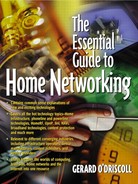ABOUT HAVI
HAVi is an abbreviation for Home Audio/Video Interoperability. It is a project that was started by eight promoter companies—Grundig, Hitachi, Panasonic, Philips, Sharp, Sony, Thomson, and Toshiba. Eighteen other participant companies have joined—Digital Harmony Technologies, Loewe Kenwood, LG Electronics, Mitsubishi Electric, Pioneer, Samsung Electronics, Sanyo, Seiko, Epson, Sun Microsystems, Tao Group, QNX Software Systems, Vivid Logic, 3A International, Infineon Technologies AG, Teralogic, Wind River Systems, and Yaskawa Information Systems. HAVi adopted the IEEE 1394 bus standard as the underlying network technology for the HAVi protocols as well as for the transport of the real-time A/V streams.
The HAVi architecture specifies a set of APIs that allow consumer electronic manufacturers and software engineering companies to develop applications for IEEE 1394-based home networks. One of the main reasons HAVi selected IEEE 1394 over other transmission protocols is because of its support for isochronous communications. The term isochronous ("iso" meaning "equal" or "identical" and "chronous" meaning "time") refers to the ability of 1394 to guarantee delivery of data packets at fixed intervals. This feature underpins its usefulness in an A/V-centric home network because it ensures that audio and video streams can be guaranteed to meet the real-time constrains, such as television at 30 frames per second. HAVi comprises software elements that facilitate the interoperability between different brands of entertainment devices within your home. Interoperability is an industry term that refers to the ability of an application running on an in-home appliance to detect and use the functionality of other appliances that are connected to the same network.
The HAVi standard specifies the home networking protocols that are required to achieve this interoperability. The HAVi architecture is an open, lightweight, and platform-independent specification that allows developers to write home networking applications. It specifically focuses on the transfer of digital A/V content between in-home digital appliances, as well as the processing (rendering, recording, and playback) of this content by HAVi-enabled devices. It does not, however, address home networking functions such as controlling the lights or monitoring the climate within the house. The HAVi middleware system is independent of any particular operating system or CPU and can be implemented on a range of hardware platforms including digital products such as cable modems, set-top boxes, integrated TVs, Internet TVs, or intelligent storage devices for A/V content. Today, in the world of analog consumer electronic appliances, there exists a number of proprietary solutions for interoperability between devices from one brand or vendor. In the upcoming world of digital technologies, HAVi extends this networking model by allowing communication between consumer electronic devices from multiple brands. Some examples of this new interoperability are:
A VCR can use the clock of the TV (e.g., as received via its satellite, terrestrial, or cable receiver) to set the time on its own clock.
A TV can program the VCR based on the Electronic Program Guide the TV receives. This is done completely by the TV: the user does not have to program the VCR separately.
When a HAVi device is plugged in to or unplugged from the HAVi network, other HAVi devices will detect this and can adapt their functionality. For instance, when the VCR is unplugged, the TV can inform the user that the programmed recordings are no longer possible and it can try to find another VCR in the HAVi network and use that one.
HAVi devices can use the display of other HAVi devices to present a user interface. For instance, the VCR could be programmed in the dining room from a TV in the bedroom.
The underlying structure for a home network based on HAVi technologies is a peer-to-peer network, where all devices can talk to and interact with all others. HAVi has been designed, however, to allow the incremental addition of new devices, which will most likely result in a number of interconnected clusters of devices. Typically, there will be several clusters in the home, with one per floor or per room. Over time these clusters will be connected with technologies such as 1394 long or wireless 1394. As the name indicates, 1394 long supports distances of up to 100 meters.
